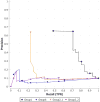Matching phenotypes to whole genomes: Lessons learned from four iterations of the personal genome project community challenges
- PMID: 28544481
- PMCID: PMC5645203
- DOI: 10.1002/humu.23265
Matching phenotypes to whole genomes: Lessons learned from four iterations of the personal genome project community challenges
Abstract
The advent of next-generation sequencing has dramatically decreased the cost for whole-genome sequencing and increased the viability for its application in research and clinical care. The Personal Genome Project (PGP) provides unrestricted access to genomes of individuals and their associated phenotypes. This resource enabled the Critical Assessment of Genome Interpretation (CAGI) to create a community challenge to assess the bioinformatics community's ability to predict traits from whole genomes. In the CAGI PGP challenge, researchers were asked to predict whether an individual had a particular trait or profile based on their whole genome. Several approaches were used to assess submissions, including ROC AUC (area under receiver operating characteristic curve), probability rankings, the number of correct predictions, and statistical significance simulations. Overall, we found that prediction of individual traits is difficult, relying on a strong knowledge of trait frequency within the general population, whereas matching genomes to trait profiles relies heavily upon a small number of common traits including ancestry, blood type, and eye color. When a rare genetic disorder is present, profiles can be matched when one or more pathogenic variants are identified. Prediction accuracy has improved substantially over the last 6 years due to improved methodology and a better understanding of features.
Keywords: biomedical informatics; community challenge; critical assessment; genome; genome interpretation; open consent; personal genome project (PGP); phenotype.
© 2017 Wiley Periodicals, Inc.
Figures






References
-
- Anstee DJ. Red cell genotyping and the future of pretransfusion testing. Blood. 2009;114(2):248–256. - PubMed
Publication types
MeSH terms
Grants and funding
LinkOut - more resources
Full Text Sources
Other Literature Sources
Miscellaneous

